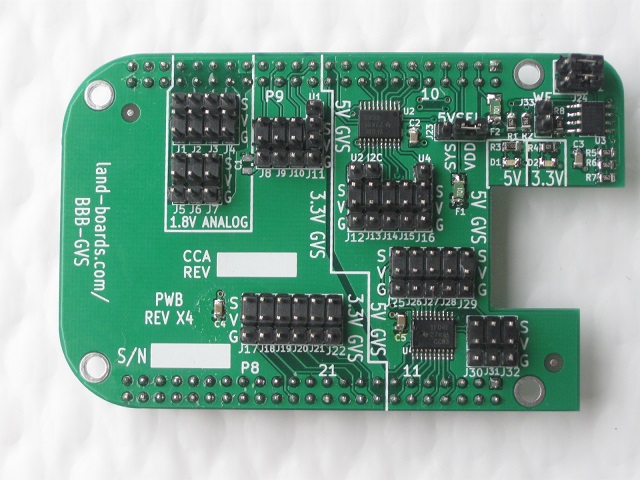BBB-GVS
Contents
Beaglebone Black cape which provides 5V GVS connections
We love the Beaglebone Black. With all of its I/O connections it offers exciting potential for embedded/connected devices. It even has real mounting holes which let the board be used for real-world applications.
When we got our first Beaglebone Black we were excited to try it with some of our Arduino GVS (Ground/Voltage/Signal) sensors and GVS output devices but couldn't since they are all 5V sensors. Sure we could cobble together some level shifters on a breadboard but in the end we wouldn't have something that could be deployed in a real application What we really wanted was a 5V Sensor shield like the one we use for our Arduino. But there were none out there. So we designed one.
Introducing the BBB-GVS cape.
Features
- (5) 5V GPIO GVS connections (auto direction detection)
- (4) 5V GPIO/Timer GVS connections (auto direction detection)
- (2) 5V UART Tx/Rx connections (auto direction detection)
- (1) 5V PWM GVS connection
- (1) 5V I2C bus 4-pin connections (auto direction detection)
- 5V pins are all ESD protected pins with 15 kV of protection
- Cape configuration EEPROM
- (7) 3.3V GPIO connections
- (1) 3.3V UART Tx/Rx connection
- (1) 3.3V PWM GVS connection
- (7) 1.8V analog GVS connections
- Resettable Fuses on 5V and 3.3V power
- Selectable 5V source
- 3.3V and 5V power status LEDs
- Beaglebone Black form factor
Technical Overview
In a nutshell, the 3.3V digital signals of the Beaglebone Black need to be changed into 5V digital signals. There are a number of discrete ways to convert 3.3V bus to 5V signals. Some of them use MOSFETs and a couple of resistors. These work OK but there are some powerful chips out there that can do the conversion even better. We looked around and found what we think is the best 3.3V<>5V data conversion chip, Texas Instrument's TXS0108. The TXS0108 is an 8-bit, bi-directional buffer with automatic direction detection. Each and every pin can transmit and receive independently and even at the same time. The part supports both open drain and push-pull operation. The part can run as fast as 60 Mb/s in push-pull operation and 2 Mb/s in open drain. This speed is fast enough enough for microprocessor GPIO pin or even the fastest serial interfaces that a microprocessor can throw at it.
What is GVS?
GVS is great for prototyping or deploy-able products. The beauty of the GVS connection is that power and ground are provided with each I/O signal. That provides the power needed to power external sensors and output devices. Otherwise splitting the one or two power pins into separate cables ends up being a real mess.
GVS stands for Ground, Voltage and Signal. It's a 3-pin unofficial standard. It uses 0.1" pitch pins. There are a large number of GVS sensors (inputs) and devices (output) parts on ebay. The sorts of GVS sensors include:
- Buttons
- Switches
- Temperature sensors
The sorts of GVS output devices include:
- Relay modules (not always wired as GVS, but they typically require 5V).
- Buzzers
- Solenoids
- Servos (require PWM output pin)
To connect a GVS sensor to a GVS card, just use a 3-wire cable.
Other Connections
The Beaglebone Black also has I2C and UART connections. These allow various devices to be connected:
- I2C Displays
- I2C accelerometers, gyroscopes
- UART GPS modules

